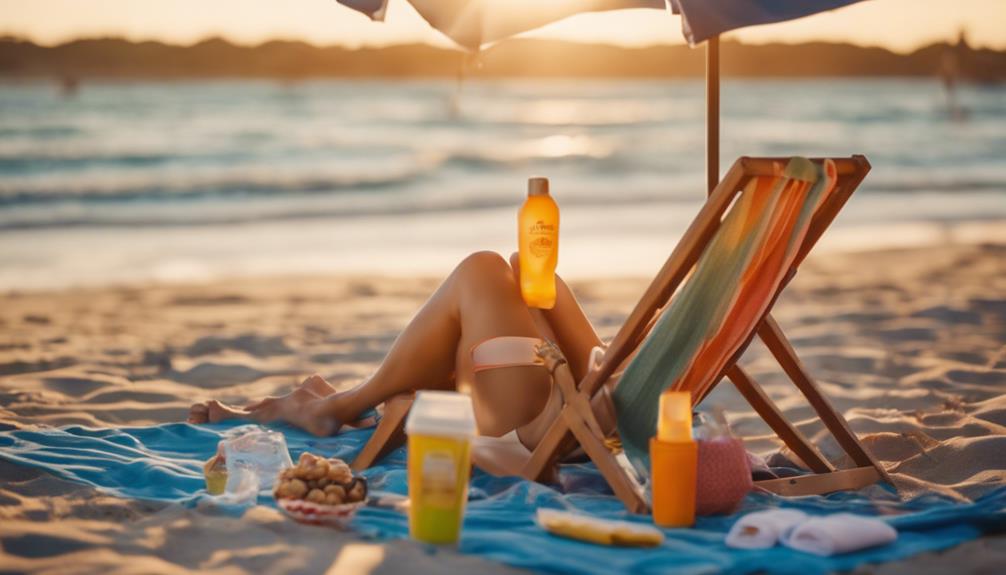To enhance your tan effectively, begin by using a high-quality tanning lotion that boosts melanin production. Change your position every ten minutes and stretch out your arms and legs to ensure uniform exposure. Turning over halfway through your tanning session helps achieve an even tan. Incorporating gentle movements while tanning can help prevent tan lines. Remember to take care of your skin after tanning; applying moisturizer right away seals in the glow. Keeping hydrated before and after tanning sessions also promotes skin health, helping your tan last longer. Interested in learning more tips and techniques for achieving the perfect sun-kissed look? Don’t miss out on what’s coming next!
Key Takeaways
- Apply a quality tanning lotion with accelerators before tanning to enhance melanin production for a deeper tan.
- Rotate positions every 10 minutes and flip halfway through to ensure even exposure and prevent uneven tan lines.
- Spread limbs while lying flat for optimal coverage, and use positioning aids for hard-to-reach areas.
- Stay hydrated by drinking water and moisturizing daily to improve skin health and tan longevity.
Understanding Tanning Lotions
Understanding tanning lotions is crucial because they greatly enhance your tanning results and help you achieve that perfect sun-kissed glow.
Tanning bed lotions, like accelerators and bronzers, play a significant role in your tanning journey. Accelerators work by boosting melanin production, allowing you to develop a tan faster. Look for key ingredients like tyrosine in bronzers, which help deepen your color.
Hydrating elements such as Shea Butter and Aloe Vera not only nourish your skin but also improve your tanning experience. To get the best results, make certain you apply the lotion evenly and thoroughly.
Customer reviews can guide you in selecting effective products tailored to your needs, making tanning lotions indispensable tools for achieving your desired tan.
Effective Tanning Techniques
To achieve the best tanning results, it's crucial to employ effective techniques that maximize your exposure and guarantee an even color. Start by rotating your position regularly during your tanning session to confirm all areas get equal sun exposure. Also, consider using positioning aids to reach those tricky spots. Lying flat with your limbs spread is ideal, but don't forget to flip halfway through for balanced results. Here's a quick reference table for your tanning sessions:
| Technique | Description |
|---|---|
| Rotation | Change positions every 10 minutes |
| Spread Limbs | Lie flat with arms and legs apart |
| Flip Over | Turn halfway through your session |
| Use Aids | Employ props for hard-to-reach areas |
Enhancing Tanning Results

Rotating your position during tanning sessions sets a solid foundation, but pairing that with the right products and techniques can greatly enhance your tanning results.
Start by applying a quality tanning lotion, like an accelerator or bronzer, before your session. These products boost melanin production and improve your tan's depth and longevity.
Make sure to spread your limbs and flip over halfway through to guarantee even exposure. You can also incorporate slight movements during your session to avoid uneven tan lines.
Focus on balancing UV exposure across all body parts, and don't forget to check customer reviews for lotion effectiveness.
Importance of Post-Tanning Care
Post-tanning care is essential for maintaining your tan and keeping your skin healthy and hydrated.
After tanning, you should immediately moisturize your skin with a quality lotion that contains ingredients like coconut oil or shea butter. This helps lock in moisture and prolongs your tan.
Avoid hot showers and harsh soaps, as they can strip your skin of its natural oils and fade your tan quicker. Instead, opt for gentle cleansers and lukewarm water.
Additionally, consider using specialized tattoo protection lotions if you have ink, as they help preserve vibrancy.
Skin Health and Hydration

Maintaining skin health and hydration is essential for achieving a beautiful, long-lasting tan. When your skin is well-hydrated, it absorbs tanning products more effectively and develops an even, radiant color.
To keep your skin in top shape, drink plenty of water and use moisturizing lotions daily, focusing on ingredients like coconut oil and shea butter. These not only hydrate but also nourish your skin, enhancing its elasticity and appearance.
After tanning sessions, apply soothing lotions to prevent dryness and maintain your golden glow. Remember, healthy skin is the key to a stunning tan, so prioritize hydration and care to guarantee your skin looks its best all summer long.
Tips for Tanning Bed Use
To get the best results from your tanning bed sessions, it's important to follow proper techniques and use the right products. Start by applying a quality tanning lotion to enhance your tan. Rotate positions every few minutes to guarantee even exposure and avoid tan lines. Lying flat on your back with your limbs spread is ideal. Remember to flip over halfway through for balanced results. Finally, maintain a comfortable posture and incorporate slight movements during your session.
| Tip | Description |
|---|---|
| Use Tanning Lotion | Apply lotions with accelerators for best results. |
| Rotate Regularly | Change positions for an even tan. |
| Flip Halfway | Guarantee balanced exposure on both sides. |
| Stay Hydrated | Drink water before and after tanning. |
| Avoid Overexposure | Limit sessions to prevent skin damage. |
Common Tanning Myths

Many people believe common tanning myths that can lead to ineffective practices and potential skin damage.
One prevalent myth is that you can't get burned in a tanning bed; this is false. Tanning beds emit UV rays, which can cause burns just like the sun.
Another misconception is that tanning lotions aren't necessary. In reality, using a good tanning lotion enhances results and protects your skin.
Some think that a base tan prevents sunburn, but this isn't true either; it can give a false sense of security.
Ultimately, many believe darker skin doesn't need sunscreen, but all skin types require protection to prevent damage.
It's crucial to debunk these myths for healthier tanning practices.
What are the benefits of using natural oils to enhance your tan?
Using natural oils for tanning transformation can have numerous benefits for your skin. Natural oils like coconut, argan, and olive oil can deeply moisturize and nourish the skin, enhancing your tan and giving it a healthy glow. These oils also have natural SPF properties, providing some protection against harmful UV rays.
Conclusion
Now that you're armed with smart techniques for boosting your tan, it's time to step into the sun—or tanning bed—with confidence.
Remember, achieving that bronzed look is more than just lying down; it's about using the right lotion, positioning, and post-care.
Don't fall for myths that lead you astray; after all, we're not in the Stone Age anymore!
Prioritize your skin health, and you'll shine bright all season long with that gorgeous sun-kissed glow.










